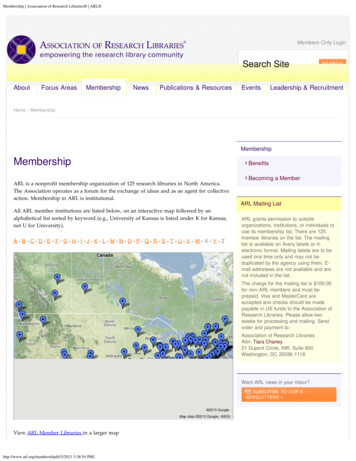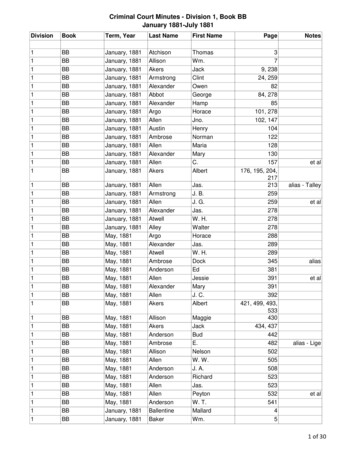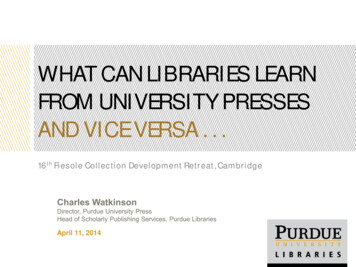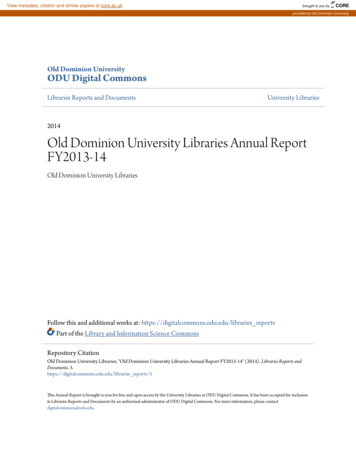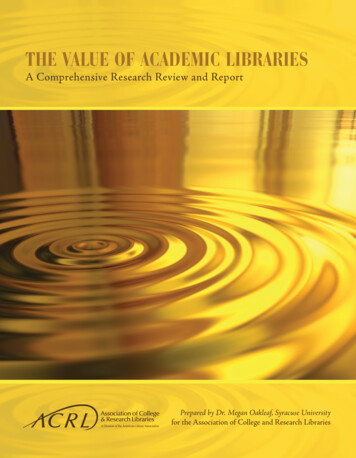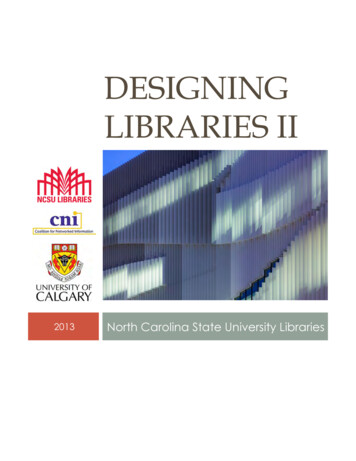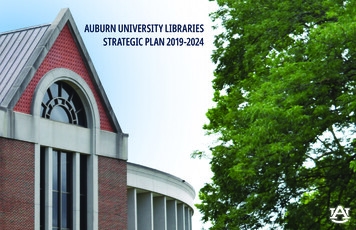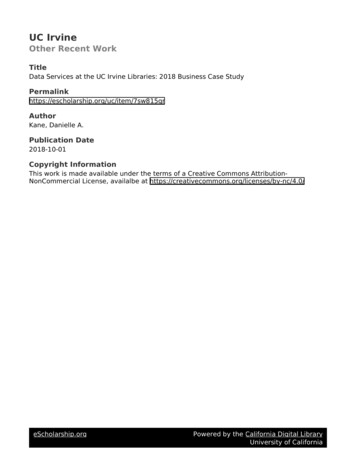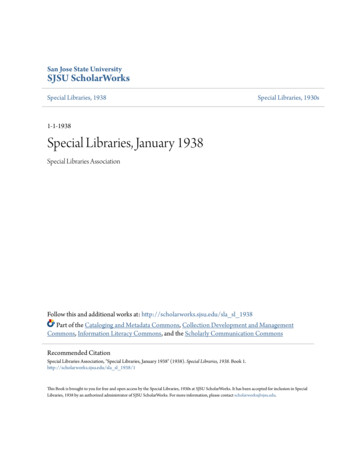
Transcription
San Jose State UniversitySJSU ScholarWorksSpecial Libraries, 1938Special Libraries, 1930s1-1-1938Special Libraries, January 1938Special Libraries AssociationFollow this and additional works at: http://scholarworks.sjsu.edu/sla sl 1938Part of the Cataloging and Metadata Commons, Collection Development and ManagementCommons, Information Literacy Commons, and the Scholarly Communication CommonsRecommended CitationSpecial Libraries Association, "Special Libraries, January 1938" (1938). Special Libraries, 1938. Book 1.http://scholarworks.sjsu.edu/sla sl 1938/1This Book is brought to you for free and open access by the Special Libraries, 1930s at SJSU ScholarWorks. It has been accepted for inclusion in SpecialLibraries, 1938 by an authorized administrator of SJSU ScholarWorks. For more information, please contact scholarworks@sjsu.edu.
Olficial Organ of the Special Libraries Asocla tionSpecial Libraries"Putting Knowledga t o Work"The Special Library, the Public, and the Public Library Marjorie E. Utt. . . . . . . . . Mary G . LacyFirst Aid for SpecialistsBanking and Economic Planning . . . Benjamin Haggoti Beckhart. . . . . . . . . Lucy 0. LmtonAn Engineering LibraryThe Library's Function in a University Bureau of GovernmentIone Ely DorityEvents and Publications . . . . .Library Magazine Articles of Interest . . . . . .,Beatrice HugerClassification Committee File Holdings.S.L.A.'s 1937 Publication. . . . . . . . . . .From the Editor's Point of View -Whither Specia.I Libraries? . . .Letters to the Editor . . . . . . . . . . . . . . .Some Sound Suggestions - Kathryn E. Peoples; Keep ProceedingsOut of Special Libraries - Jean Macalister; W h y No MuseumArticles? - Cynthia Grifin; Special Libraries - Again - Margaret S. Gill; Meeting the Readers' Needs - Ruth von Roeschlaub;Training Problems - Margaret M. Herdman; Definitions to theFore! - Donald Coney; Another Definition - Isabel L. Towner.Publications of Special Interest . . . . . . . . . . . .Indexed in h d u t r i a lArb Index and Public Affairs Information ServiceJANUARY 1938VOLUME 29NUMBER 1
SPECIAL LIBRARIESMARIAN C. MANLEY,EditorJanuary, 1938Vol. 29, No. 1The Special Library, the Public, and thePublic LibraryB y Marjorie E. Utt, Assistant LibrarianStateMedical Library, University of Californiai t is entirely unneces0FsaryCOURSEto suggest to a group oflearned librarians that the driving forcebehind any library, general or special, isservice. Yet, well as we know that fact,we can agree with Miss McCannls patlittle quatrain :"We demand perfect service wherever we go,We're enraged at the slightest neglect.But consider the poor humnn race as it is,And it seems quite a lot to expect."Generally speaking, special librarieshave their own clientele, the needs andinterests of whom are given first place.A medical library, for example, considersthe medical profession its public; lawlibraries will include John Smith, Esq.,and his colleagues; our banking andinsurance libraries cater to the moremonetary-minded of the population.Fundamentally, the aim of the speciallibrary is to serve within its field, and thebetter our special libraries, the betterpeople we should develop within thecommunity - more efficient doctors,lawyers, bankers, welfare workers -evenmore intelligent Congressmen. If we canencourage the professions t o make themost of the libraries intended for them,we can hope to raise the general standardsof our communitv. Can we not assumethat, the more our libraries act as postgraduate courses, keeping the doctor or1 McCann, Rebeccn. "The Cheerful Cl crub." 2nd. scr.Covlcl, Friede, 1930dentist better able t o give patients everyadvantage, the lawyer every legal benefit, and so on through the specialties, themore our general public, being in turnserved by those specialties, is benefited?Then there is the question of use ofspecial libraries by the public. What arewe to do about John Jones, private citizen, whose night school course in economics requires that hc write a n exhaustive paper? And he has probably chosensome complicated subject, from thoseoffered, because of the fact that h e hasan unusually inquiring mind, and aninsatiable desire to " track down " everyphase of his interest. T h a t interesthappens to be the effects of economicconditions on the people whom he seesaround him. His search a t the publiclibrary shows him that he needs morematerial than even their very exhaustiveindexes can yield. He wants the psychological and physiological aspects, anddiscovers that many references are available only a t the medical library someblocks away; he wants to find out whatbills in the state legislatul'e have anybearing on his subject -billsrisingfrom the public's need for adequatemedical care and economic and socialwell-being. John wishes to trace some ofthe legal cases which sound interesting;he wonders if other libraries in the citymight not have material of special interest to him. Very well. What are we t o do?
SPECIAL LIBRARIES4I s John Jones t o be entitled to materialfrom these various libraries? Will he berefused because he is not a doctor or alawyer, or because he has not a card ofintroduction from some well-known social worker? Will the public library,which wishes t o feel free to send himelsewhere for special research, later havemisery heaped upon its unsuspectinghead, because John Jones has been told"sorry, but this library is open only toso-and-so-and-so."If any library's chief function is service,then t h a t means that our material shouldbe made available, not left to lie idle incold storage. Dr. Llewellys F. Barker, inan address made at t h e 1924 annualmeeting of the Cleveland Medical Library Association, said this: "I have discovered a rather remarkable fact -thatthe greater the demands you make upona medical library, the more welcomeyou seem to be in i t ; instead of regardingyou as a nuisance, those .strange creatures, the librarians, behave as thoughyou were actually conferring a favorupon them by increasing the amount ofwork they have to do." l This may applyt o any library service - medical librarians have no corner on that.Specifically, each library has its owntype of service, which it seeks to promote.T h e State Medical Library here isfounded on the idea as originally startedby Mr. Johnson Brigham, until his recentdeath, veteran state librarian of Iowa,and by Dr. Gersharn Hill, with MissFrances van Zandt as active organizer.T h e second state to have the set-vice wasWisconsin, and California is the third.I t might be called a postal adaptationof the Bookmobile idea, as material isdistributed t o outlying districts havingnot-so-easy access t o larger city libraries-but i t is done by mail, and not byautomobile. T h e chief service is that ofmailing regularly, as published, current1Aademy of Medicine, Cleveland. Bulletin, 1924.Vol. 29, No. Imedical journals, to physicians all overthe state - or noncurrent, if they wisht o keep them for a greater length of time.For no charge but the transportationthese are sent out regularly from a mailing list, and thus doctors are kept constantly abreast of the latest medicalliterature, and a t nominal cost. Requestsneed be made only once, and the journals are theirs, for as many weeks ormonths or years as they desire. We havea very small budget (which seems t o bethe hue and cry of most libraries) onwhich we buy no books but those ofgeneral reference needed a t the library.Through the kindness of other librarieswe are able to borrow much of whatwe d o not have.Doctors alone receive material regularly. However, in our five years ofservice, we have amassed many backfiles of journals, as well as those from oursubscriptions, through gifts and exchange of duplicates - we have alsoreceived many books from many sources.And all this has enabled us t o build u p agreat deal of material, used for referencework, both for those coming into thelibrary to read and to withdraw journals,and to those telephoning or writing ortelegraphing - and requests are filledthe same day a s received, wherever possible. A collection of some 20,000 prints,t o date, kept constantly catalogued, thepromptness in locating material andsending it out a t very reasonable cost,further assists.But the fact that we are special libraries, serving distinct groups, does notseem reason for denying service to thoseoutside those spheres, who have legitimate need of it, and who will makeproper use of it. In our own field, medicine, we have chemists, psychologists(and the all-too-frequent psychologist),public health workers, dentists, WPAworkers, teachers, ministers, veterinarians, many earnest and d p e r a t i v e peo-
January, 1938SPECIAL LIBRARIESple, many sent from the public library,from other special libraries, many justwandering in. We do what we can forthem, always with the understandingthat our doctors do come first -andthat if need be material can be called in.But, like John Jones and his paper, thereis the talented young illusirator, whomust study the very detailed drawingsof the technique of hernia injections,preparatory t o making drawings of her0c.n for the book her doctor employer iswriting; the young and earnest YMCAworker who has recently taken a SundaySchool class, and wished adequate matcrial on eugenics; the WPA workers,preparing pamphlets for junior highschool grades, under the supervision ofthe Board of Education - on alcoholismor speech defects or vision acuity; thelawyer needing anatomical charts of feeschedules, fdr his medico-legal cases.Such requests are too numerous to mention - you all have them, no matterwhat field your library covers, and thesepeople need our help. I t should be understood that somehow material in speciallibraries should either augment or supplement that to be found in the publiclibrary.Department and branch librariansshould feel free to send people to speciallibraries, knowing that legitimate problems will not be ignored, but will be dealtwith sensibly. Special libraries shouldsend the more general requests to thepublic library - we might thus not onlyavoid unnecessary duplication of espenseand material but also generously increaseeach other's circulation. AIaybe in somemore halcyon day we shall have a verydefinite system of exchange betweenpublic and spccial libraries - a cardfrom one to the other, or a recommendation, if not from library to patron, atleast from library to library. We aslibrarians should not act as though ourcollection is a hallowed and not-to-bc-5touched treasure, for only t h e chosen fewto use.There are, of course, on the other hand,reasonable objections t o t h e public useof a special library. First, many specialcollections are reasonably intended onlyfor the research workers whom they aredesigned to serve - a s for example theintensely specialized material t o befound in the klt. Wilson Observatory.Second, many people are decidedlymade unhappy by small bits of information - "a little knowledge is a dangerous thing" and this does seemparticularly to apply t o those using amedical librarv. Definitions t o be foundin medical dictionaries are sometimesquite as confusing a s the word to bedefined. A man may unintentionallymisrepresent what he thinks he haslearned - and the frequent disagreeableillustrations are often more discouragingthan otherwise. Third, some will saythat if the public is t o have access to thespecial libraries, why have special libraries a1 all? Whv not leave all malerialon all subjects to be purchased a t thepublic library's discretion? These objections are mentioned only becausc theydo exist, and must be reckoned with.We can, also, have reading privilegeswithout borrowing privileges, for themembers of the general public whom wefeel are not legitimately entltled towi.ihdraw material. We have to determine how much can be lent, and ho\vmuch is to be retaincd in the lil raryforthe calls which we all have lo till constantly. \l'e musl cletern ine whetherit is wisest for the public i o be in roducedto the special library before using i t a t ,111- in medical libraries people are oftensent by doctors, or lctters or 'phone callsserve as introduction. But it is well forpotential as well as actual clientele to beaware of the facilities and resources available in any library - in the way ofmanuscripts, bibliographies, pictures,
6SPECIAL LIBRARIESspecial lists of any sort, catalogs, indexes, etc. These are all points whichcannot be gone into thoroughly here,b u t can be mei tionedin order t o stimulate interest and comment.The financial needs of cooperationamong libraries speak for themselves.If it could be understood t h a t t h e publiclibraries need not buy everything, public' demand t o the contrary - knowing t h a tmotion picture, law, medical, petroleum,bank, insurance, tax, ad injinikim, libraries, d o exist and can be used, eachlibrary could thus concentrate moreheavily on its own specialty, feeling freeto supplement elsewhere. Ideals presumably cease t o be ideals when attained-wemust have something towardwhich to work. But sometimes we dofor good, big, stiff realities. And aclosely knit cooperation among librariesis a n ideal which might a t least approachreality, pushing aside that awful spectreof unnecessary duplication of funds andeffort, and also wear and tear on the veryvaluable nerves of both librarians andgeneral public. T o duplicate expensivecollections in a community is unwise.Certainly cooperative endeavor in highlyspecialized fields is vastly necessary the Los Angeles Public Library, for instance, wisely refrains from buying, inmedicine, anything in diagnosis andtreatment, leaving that t o medical libraries. Yet in order for everyone tobenefit there must be a real knowledgeof the location of important collectionsand special resources available. Interlibrary lending could be encouraged.Libraries specializing in different fieldsmight be located a t conveniently scattered places. For instance, one havingmedical material from 1925 t o date couldbe kept a t one place; a t another we couldhave the library which makes everyeffort to secure the older material up to1925, collecting earlier manuscripts andout-of-print books, neither library buyingVol. 29, No. 1everything, in the field of medicine.This can apply to any specialty, and ofcourse implies a general catalog for general a s well as for special use, givinglocation and availability of all holdingsof all libraries. I t would mean less duplication of time, effort and expense. Ibelieve the California Library Association is now making such a survey oflibrary accessibility, in the interest offinding out what i t can of inter-libraryloan privileges. New Jersey is now making a union catalog - as one of probablymany which are being carried on - tomeet a very pressing need. Service andcoijperation, rather than ownership,should be the kevstone in our work.And the library can play a very significant role in preparing the people of itslocality t o live larger and fuller and moreabundant lives.C. B. Shaw, in his article on "CreativeLibrarianship," says this: "Librariansas a group have one common goal; t ounderstand, to sympathize with and tourge on, t o direct the thinking of, totransform and develop the ideas . .of those who can, and will, when properlydeveloped, mould this sorry world alittle closer to the heart's desire." 1Libraries must needs have an adequate philosophy of education, feelingthat they are an active educative force.Special libraries can indeed be of thenature of consultant services, for thepublic and public library.I should like to close with somethingwhich Louis Pasieur said, on the occasion of his 70th birthday, a t the exercisesheld in t h e Sorbonne, on December 27,1872 - Pasteur's sound advice to thegroup of young physicians then sittingbefore him: "Whatever your career maybe, do not let yourselves become taintedby a deprecating and barren scepticism;do not let yourselves be discouraged bythe sadness of certain hours which pass.
January, 19387SPECIAL LIBRARIESover nations. Live in the serene peace oflaboratories and libraries. Say to yourselves, first: 'What have I done for myinstruction?' and, as you graduallyadvance, 'What have 1 done for mycountry?' until the time comes whenyou may have the immense happiness ofthinking that you have contributed insome way to the progress and to the goodof humanity. But, whether our effortsare, or not, favored by life, let us be ableto say, when we come near the greatgoal, ' I have done what I could."' Are.we, as librarians, doing what we can?First Aid for SpecialistsBy Mary G. Lacy, LibrarianBureau of Agricultural Economics, U. S. Department of Agriculturesaid many years agoCONFUCIUSthat, "To search the old is t o findthe new"; Abbot Joachim wrote in thethirteenth century that, "The knowledgeof the past is the key t o things to come" ;and Horace Mann followed with thestatement, "As each generation comesinto the world devoid of knowledge, itsfirst duty is t o obtain possession of thestores already amassed. I t must overtakeits predecessors before it can pass bythem." Perhaps these statements are asgood a text as any from which to beginto talk about First Aid to S ecialists,asprovided by the bibliogfaphical serviceof the Library of the Bureau of Agricultural Economics. The economists ofthe Bureau of Agricultural Economicsbelieve that a knowledge of the past canillumine the future and may preventcostly mistakes and loss of time.The desperate agricultural situation ofthe last few years has forced the Administration to plan for relief not only for therural population but for all of us, becausethe plight of the producer of agriculturalcommodities was affecting the wholebusiness structure of our country andbringing misery and unemployment tomillions of our people. In August, 1933,the Office of the Secretary of Agricultureasked the Library of the Bureau of Agricultural Economics to compile a bibliography on Agricultural Relief 1 whichI Apricultural Economics Bibliography No. 50, 1933.would show what had been proposed anddone to improve the condition of agriculture. Great haste was necessary a s thematerial was to be used in the preparation of the Department's brief for thefirst court case to test the AgriculturalAdiustment Act. Two of the men working on the brief isedthe material as itwas collected and abstracted in t h e library, in the attempt to show t h a t thewelfare of agriculture was essential t o thegeneral welfare of the country. Thisbibliography, which is 327 pages inlength, was compiled and issued in mimeographed form in ten days from the dayi t was begun. Practically everyone inthe library, as well as others on specialdetail, worked on it. The bibliographywas issued in time to meet the immediateneed for information on agricultural relief measures proposed or adopted, andwas later indexed and issued in our r e y lar series.In connection with the efforts to relievethe plight of agriculture which were madea t the time of the depression followingthe war, four bibliographies were cornpiled to show different types of effortwhich had been used in the past, namely,"Government Control of Exports andImports in Foreign C o n t r i e s . ""Price Fixing by Governments, 424 B. C. to1926 A. D.,"a Bounties on Agricultural' Ibrd., No. 12. February, 1926.Ibrd.No. 18, October.1926.
SPECIAL LIBRARIESProducts,"' and "Control of Productionof Agricultural Products by Governm e n t . "These four bibliographies wereused a t that time and have been steadilyused since. When the later depression of1929 came, increased interest in them wasshown, and a bibliography entitled " Government Control of Cotton Productionin the United States 1933-1935"3 wascompiled and issued in January, 1936.The appalling extent of unemployment after 1929 brought to the forefrontthe possible use of the land for the reliefof unemployment, and we were asked toinvestigate the literature in this field.Our Bibliography on Land Settlementwith Particular Reference to Small Holdings and Subsistence Homesteads, whichwas published as Miscellaneous Publication 172 of the United States Department of Agriculture, was issued in August, 1934. It was an attempt to makeavailable for economists and others theliterature which would be helpful in astudy of this question. I t lists referencesto the literature on the subject for bothforeign countries and the United States,and is a part of our larger project of investigating the literature of Land Utilization in the United States and ForeignCountries and Land Policies.' Both ofthese bibliographies have been used,while in progress, by those who were developing a program and policy for theTennessee Valley Authority and forvarious subsistence homestead projectsin various parts of the country. In onecase, I recall that for three weeks one ofthese agencies had a typist working withour unfinished material copying references for the use of investigators. Wecould not get it ready fast enough tomeet the demand for it, and some partsof i t were almost morn out before theslips were finally copied for printing.IApdcultural Emnomlc. Bibliography So. 20. July, 1927.No. 23. December, 1927.Ikd. No. 63. January, 1936M sellaneousPubllcallon No 281 (In prcsg).Ib d.Vol. 29, No. 1The Land Utilization bibliography isnow nearing completion. We have almost finished reading the galley proof.I t consists of more than seven thousandannotated entries, and comprises in addition to the land use references muchmaterial supplementary t o the Land Settlement bibliography. I t attempts t opresent selected references on the economic aspects of land utilization and landpolicy in the United States and in foreign countries published for the mostpart during the period 1918 to 1936.Relatively few references t o theearly landpolicy of the United States and the individual states have been included,mainly because a bibliography on thissubject is in preparation in the office ofthe Agricultural History Specialist ofthe Bureau of Agricultural Economics.Anyone who is interested in the tnethodology used in such an extensive piece ofwork would undoubtedly be interested ina paper by a member of our staff read a tthe American Library Association a t itsmeeting in 1936, entitled MethodologyUsed in Compiling a Bibliography in theField of Agricultural Economics.6The demand for the material relatingto farm tenancy was so widespread andso insistent that we found i t necessary toissue a separate bibliography on thatsubject6 before the land utilization bibliography was finished. The interest inthe Southern sharecropping system is onereason for the wide demand for this material. Both the farm tenancy and theland utilization bibliographies are indexed in great detail so that the materialwhich they contain is made more quicklyavailable. I could multiply instances ofthe current use of our bibliographies butthe instances cited are probably enoughto show that they are used in this way.An instance of a definite tie-up of bib-'Supplement l o Agrrcultural Librarv Note¶, v. 11, No. 5.May. 1936.'Farm Tenancy In the United States. 1918-1936. A d rulLutal Economics B bl omaphyNo. 70. June. 1937.
January, 1938SPECIAL 1-1BIIARIES9liographical work with action programsmight be found in connection with theReport of the President's Committee onCrop Insurance. Specialists in the Bureauof Agricultural Economics and elsewhere in the Department prepared thereport of this committee and were givena verv short time indeed in which to dothe necessary work. The library wascalled on t o compile a bibliography fortheir use and to send them the materialas i t was located from various sources.Fortunately, work on a bibliography onCrop and Livestock Insurance had already been begun, and we had a gooddeal of material ready. The work waspushed full steam ahead, and our 263page bibliography was issued almostsimultaneously with the Report of thePresident's Committee on Crop Insurance issued as House Document 150 ofthe 75th Congress, 1st session.Another instance of the close relationship between bibliographical work andeconomic research was given less than ayear ago, when I was hurriedly calledinto a conference one morning and askedif I could have a bibliography ready bynoon the next day for inclusion in a reportthat was being prepared on the incidenceof the processing tax. I said that i t wouldnot be much of a bibliography, but thatI could Dresent a short list of references.We went t o work, and our bibliographyentitled " Incidence of the ProcessingTaxes under the Agricultural Adjustment Act issued in January, 1937, is theresult. Needless to sav,- . it took much morethan 24 hours, but it was found that moretime was available. I t has been widelyused in the preparation of the recentreport a issued by the Bureau of InternalRevenue and the Bureau of AgriculturalEconomics.Bibliographical work is undoubtedlynow recognized as basic in research. I nthe library of our Bureau, we feel thatour major work is to so organize the literature in the field of Agricultural Economics that it can be quickly foundwhcnever needed. This sounds thoroughly trite, I realize, but the doing of itis anything but stereotyped or trite. Oneof the means we use t o accomplish thispurpose is to read 398 current periodicalsand newspapers as they are received.This work is divided among i h e variousmembers of the staff, who can be irustedto recognize significant material. Descriptive notes or abstracts of such materialare made currently for use in the preparation of our periodical Agricultural Economics Literature and afterwards filed bysubject so that they are ready for use a ta moment's notice. All the books received in the library are examined andthose to be included in AgriculturalEconomics Literature are selected. Forsome reviews are made; for others descri tivenotes or abstracts. I t is thisconstant day-by-day work t h a t enablesus io meet rush demands when theycome. One of the most outstanding results of this systematic reading is t h eeducation of the library staff. itself. I tkeeps the staff on tiptoe t o see the relationships of subjects and to get the material filed where it will really produceresults when needed. I t also gives an appreciation of the very fertile area on theperiphery of our subject. I t vitalizes thedaily work eilormously and graduallydevelops on the library staff, specialistsin certain parts of the. field.1 Agr culturalEconomice Blbllo mphyNo 67. November.1936.1 Agricultural Economics Bibliozraphy No. 68. January,1937.3 An analyela of the effects of the processing taxes levledunder the Agricultural Adjuslmenl Act. Prepared by theBureau of Agrlcuituml Economics, U utedStatea Department or .\zrlculture (under the dlrcctlon of F.L. Thomscn).111 pp. Wnshington. U. S. Govt. Pnnt. off., 1937.At hcnd of title U. S. Trcnsury Department. Burmu ofInternal Revenue.
SPECIAL LIBRARIESVol. 29, No. 1Banking and Economic PlanningBy Belljamin Haggott BeckhartAssociate Professor of Banking, Columbia UniversityINNO country can monetary andbanking policies be adequately understood without a careful analysis of thexonomic and political background. Monetary and banking systems can not bestudied as if they were in a vacuum. Intheir policies and operations, they reflectnot only business practices but evenmore fundamentally they reflect thepr&Iing economic philosophy.I n the world today, there are roughlyspeaking two rival economic creeds: theemnomic liberalism of the United Statesand of the democratic nations of WesternEurope and the totalitarian philosophyof Germany, Italy and Russia. The fundamental differences existing betweenthese two economic philosophies must beanalyzed if we are to understand fully themonetary and banking policies which arebeing followed in various countries. Thissimply means that the activities of thecredit system must be interpreted fromthe point of view of the entire environmental situation.Complete economic liberalism, or laissee faire, has never been tried. In a worldof enlightened human beings, really conscious of their long-run best interests, itdoubtless would result in an ideal soaety. Pressure groups exerting greatpolitical influence along with the discovery that human conduct can beirrational have forced a thousand modifitzitions in practice. In response to thepolitical pressure of various economicgroups, tariff laws have been enacted,subventions granted gold and silverproducers and farmers, and monetaryand banking systems have been distorted from their true functions. Inrecognition of the short-sightedness ofmankind, factory inspection laws, workmen's compensation acts, social insuranceIegislation have been placed on the statute books; and the conservation of natural resources has been entrusted to thestate.Opposed to the modified economicliberalism of present day Western Europe, stand the totalitarian philosophieswhich as indicated dominate politicaland economic life in Germany, Italy andRussia. There economic activity isordered from above. The individual isunimportant. Consumer buying is rationed, all business activity is dedicatedto the interests of the state. Such sweeping control of all economic activity andpersonal life is incompatible with politicaldemocracy and it is not surprising t h a ttotalitarianism developed in those nations which did not know or which wereonly slightly acquainted with democraticprocesses.To revert to the topic raised a t the beginning of this paper, how does theeconomic philosophy prevailing in aparticular country, whether i t be economic liberalism or totalitarianism, affectmonetary and banking policies? In thetotalitarian state i t is taken for grantedthat the banking system is to be used asan instrument of national policy. Banksare not free entities. Their operationsmust fit into the national plan. Theyhave little choice in the selection ofclients and in the apportionment ofcredit.In the totalitarian countries the investment functions of banks are broughtunder a like degree of control. Un
SPECIAL LIBRARIES MARIAN C. MANLEY, Editor Vol. 29, No. 1 January, 1938 The Special Library, the Public, and the Public Library By Marjorie E. Utt, Assistant Librarian State Medical Library, University of California 0 F COURSE it is entirely unneces- sary to suggest to a group of learned librarians that the driving force
